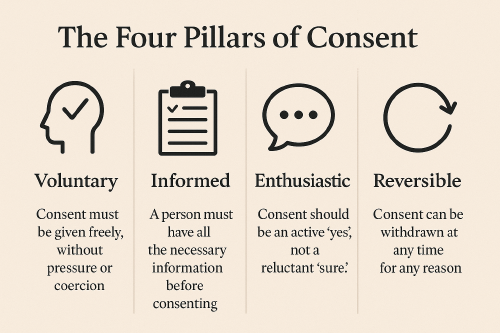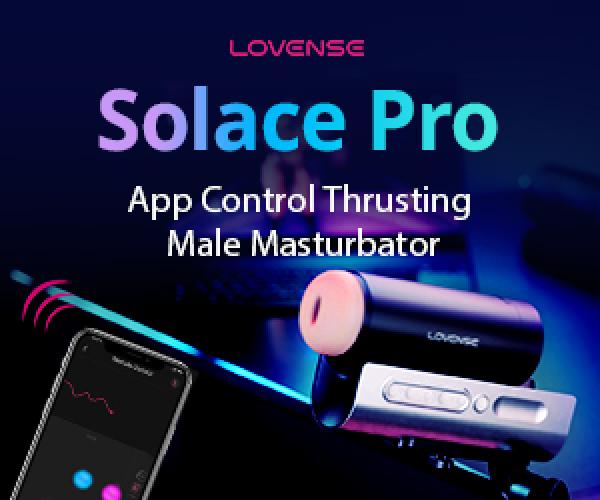Consent, Communication, and Negotiation
Why "Yes" is just the beginning in BDSM relationships
Published: July 28, 2025
Tags: BDSM Consent Communication Safe WordsWe may make money when readers purchase items through our links. Disclosure

Discover how consent, safewords, and communication build safer, hotter BDSM. The hottest scenes start with a single word: yes. But we’re going deeper.
Let me tell you a little secret: the sexiest part of BDSM isn’t the ropes or the whips. It’s not the collar or the cuffs. It’s not even the breathless moan when your submissive melts under your touch.
It’s the conversation that happens before any of that. The conversation that allows all of that to happen.
BDSM without communication is like a bondage scene without scissors—risky, messy, and asking for trouble. But done right? 🤌 Consent and negotiation become the foundations of something deeply erotic, intensely intimate, and wildly freeing—for both Dominant and submissive.
What Does Consent Really Mean?
Consent isn’t a checkbox. It’s not just “Do you want to?” followed by “Sure.” That might be enough for vanilla hookups, but in kink, we hold ourselves to a higher standard.

Consent within a BDSM scene must first and foremost be fully informed, all parties must fully know and understand what they are getting into. Once everyone is informed, that consent must be specific to what is happening and who it is happening with and it must be freely given, without guilt, pressure or manipulation. Finally, that consent must be ongoing. In a potentially rapidly changing BDSM scene, a yes at the beginning does not always mean yes forever. You must always be checking in with each other. And don’t forget that consent is not just a submissive partner consenting to a dominant one, it goes both ways.
If I have control, it’s because you gave it to me. And when a submissive offers that gift freely and thoughtfully? There’s nothing more powerful.
Consent Frameworks: Different Paths to Playing Safe
Even within BDSM, we don’t all agree on how to define “safe.” That’s okay—we have frameworks to help guide us.
SSC: Safe, Sane, and Consensual
This philosophy is often the starting point for newcomers to BDSM, and for good reason. It emphasizes the importance of keeping play physically and emotionally safe, making choices that are mentally sound, and—most critically—ensuring enthusiastic, informed consent at all times. It leans on the idea that if something isn’t safe or if it compromises someone’s mental clarity, it shouldn’t be part of the scene. It’s the training wheels of kinky frameworks: structured, simple, and aimed at minimizing harm while maximizing trust. And trust me—there’s nothing boring about playing with care and clarity.
RACK: Risk-Aware Consensual Kink
This approach doesn’t sugarcoat reality—it accepts that not every kink activity can be guaranteed “safe.” Breath play, edge play, knives, and even intense emotional dynamics all come with inherent risks.
What makes RACK powerful is that it doesn’t shy away from those truths. Instead, it demands that all participants be fully aware of the potential consequences and still choose to consent. It’s a grown-up version of consent—serious, transparent, and deeply respectful. As a Dominant, I find RACK aligns with how I lead: I offer clarity, preparation, and care, not illusions. And when my submissive chooses to surrender with eyes wide open? That’s not just consent—that’s devotion.
Personally? I’m a fan of RACK. I don’t promise safety—I promise transparency. I think that is hotter anyway.
Limits: Your Map for Safe Adventure
Every submissive is a unique universe of desires, boundaries, and curiosities—and the only way to navigate it safely is with a map. But not a boring map that you need a PhD to fold back up. A fun, sexy, map with a writhing submissive being the destination. But remember: the same can be said for a dominant as well to any submissives reading this.
Hard Limits
Hard limits are the bright red stop signs. These are the activities, words, or dynamics that are entirely off the table—non-negotiable, no exceptions. Maybe it’s a type of play that triggers bad memories. Maybe it just doesn’t appeal. Either way, a Dominant’s job is to honor those limits with absolute consistency.
Soft Limits
Soft limits are a bit more flexible. These might be activities that require a lot of trust, careful conditions, or a certain kind of mood. It’s not a firm “no,” but it’s a cautious “maybe… under the right circumstances.” Sometimes that caution is where the richest conversations begin.
Everything Else
Then there are the wonderfully wiggly edges of a submissive’s curiosity—the things they’re unsure about. I call these the “Hmm, maybe…” zones. These are the whispered confessions, the playful what-ifs, the parts of a limit list that invite exploration.
Knowing the difference between these categories isn’t just about risk management—it’s about deepening intimacy. When a submissive trusts you with their limits, they’re handing you the keys to their safety and their pleasure.
And as a Dominant? I don’t take that lightly. I study that map like it’s a treasure hunt.
Pre-Scene Negotiation: Yes, It’s Foreplay
Here’s the truth: a good negotiation is sexy as hell. Before a scene, we talk. I ask questions. Lots of them.
- What are you in the mood for tonight?
- What parts of your body are off-limits?
- How do you want to feel when we’re done?
- What are your aftercare needs?
- Any words, roles, or sensations that are triggering?
Negotiation isn’t boring—it’s where the tension starts to build. It’s the moment your submissive begins to offer themselves, and I start planning what I’m going to do with that gift.
And if they blush and squirm as they list their soft limits? Well, that’s just a bonus. 😈
Safewords: The Sexiest Safety Net
Even the most obedient submissive needs a voice.
That’s where safewords come in. A safeword isn’t a weakness—it’s a superpower. It means your partner trusts you enough to feel safe stopping the scene.
I personally recommend the traffic light system:
- Green: I’m good. More, please.
- Yellow: Something’s off. Slow down or check in.
- Red: Full stop. Now.
Non-verbal options matter too—tapping out, holding an object, or a pre-agreed signal for scenes where the mouth is… otherwise occupied.
If your sub never uses their safeword, fantastic. But they should always feel like they can. And you as a Dominant should trust your sub to feel comfortable enough pushing into that yellow territory when you think they can handle it.
Aftercare: The Quiet Power of a Good Come Down
Aftercare isn’t just snacks and snuggles. It’s communication, decompression, and emotional safety. Every scene is a journey—and every journey deserves a gentle landing.
Some subs want praise. Some want to cry. Some want a sandwich and silence. Some adamantly want anything but silence.
And me? I want to know:
- How did you feel?
- Was there anything that didn’t work for you?
- Is there anything I can do better next time?
That kind of feedback makes me a better Dominant—and deepens the trust we share.
Consent Beyond the Scene
In longer dynamics (especially D/s or 24/7), consent doesn’t get checked off once and forgotten. It lives between us. It’s in every order I give and every “yes, Sir” I receive.
Protocols, rituals, titles—all of it only matters if it’s still welcome.
Even if I have full control of your body, your voice is never surrendered.
When Things Go Wrong (Because Sometimes They Do)
Nobody’s perfect. Even experienced Dominants miss a cue, forget a limit, or get caught in the moment. What matters is how we respond.
If I screw up? I own it. I apologize. I reflect and repair.
And if a partner isn’t willing to do that for you? That’s not Dom or Alpha or big dick energy. That’s a red flag.
Final Thoughts: Power, Earned and Shared
Consent is more than permission—it’s a gift.
It’s a submissive saying: “I trust you with my body, my boundaries, my vulnerability.”
Do not take that responsibility lightly.
Because when we build something on honesty, clarity, and care… the scenes get hotter, the submission gets deeper, and the connection? It becomes something you can’t fake.
So go ahead:
Talk it out.
Ask questions.
Set your limits.
Choose your safeword.
And then? Let go. I’ve got you.
Wolf 🐺


